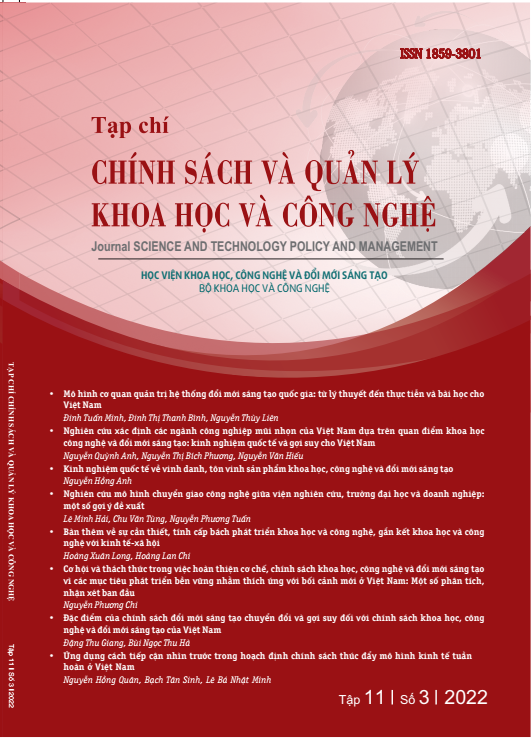Application of foresighting approach in policy making to promote the circular economic model
Keywords:
Economy, Circular economy, Foresight approach, STI policyAbstract
Addressing the challenges of inclusivity and sustainability in the context of the 2030 Agenda for Sustainable Development requires: (a) broaden the strategic focus of science, technology and innovation policy (STI) to mainstream social challenges into the core of the Program; (b) mainstreaming the direct and indirect contributions of innovations to the economic, social and environmental aspects of sustainable development; and (c) promote transformative innovations with the potential to replace existing unsustainable systems and practices. The article provides international experience in applying the foresighting approach to STI policymaking in the direction of promoting transformative innovations with the potential to replace the traditional growth economic model to a circular economy model. Based on analyzing the status of the application of the foresight approach in Vietnam and international experience, the article proposes some solutions to further promote the application of the foresight approach in Vietnam in the context of Vietnam’s transform of its economic model towards a circular and environmentally friendly direction.
Code: 22060601
Downloads
References
Cameron A và cộng sự (2019). Tương lai nền kinh tế số Việt Nam hướng tới năm 2030 và 2045. CSIRO, Brisbane, Úc.
Cameron A, T. Phan, J. Atheron (2018). “Việt Nam ngày nay”. Báo cáo đầu tiên của Dự án Tương lai Nền Kinh tế số, CSIRO, Brisbane. Úc
UNCTAD (2019). “The role of science, technology and innovation in building resilient communities, including through the contribution of citizen science”. Report of the Secretary- General. Geneva, 13-17 May 2019.
Apple (2017). “Environmental Responsibility Report. 2017 Progress Report, Covering Fiscal Year 2016”. <https://images.apple.com/environment/pdf/Apple_ Environmental_Responsibility_Report_2017.pdf>.
Bressanelli, Gianmarco, Federico Adrodegari, Marco Perona, and Nicola Saccani (2018). “Exploring How Usage-Focused Business Models Enable Circular Economy through Digital”. Sustainability 2018 10 (639). DOI:10.3390/ su10030639.
Cameron, A, Bach Tan Sinh and Sophiana Chua (2022). “The formation of a new community-of-practice to bring together public service foresight practitioners and inform science, technology and innovation activities across ASEAN Member States”. The Journal of Future Studies. (Forthcoming).
Cuhls, K (2017). “The Potential and limitation of Foresight. Conference Power from Statistics”. 19 October 2017. Fraunhofer Institute for Systems and Innovation Research. <https://ec.europa.eu/eurostat/cros/powerfromstatistics/DET/PfSPresentation Slides-Cuhls.pdf>.
Cuhls, K., (2003). “From forecasting to foresight processes? new participative foresight activities in Germany”. Journal of Forecasting, 22(2-3), pp.93-111.
Cuhls, K., (2003). “Government Foresight Activities in Germany: The Futur Process”. The second international conference on technology foresight.
Cuhls, K., Erdmann, L., Warnke, P., Toivanen, H., Toivanen, M., Van derGiessen, A., et al. (2015). Models of Horizon Scanning - How to integrateHorizon Scanning into European Research and Innovation Policies. Brussels: European Commission.
Ellen MacArthur Foundation (2016). “Intelligent Assets: Unlocking the Circular Economy Potential.” <https://ellenmacarthurfoundation.org/assets/downloads/ publications/EllenMacArthurFoundation_Intelligent_Assets_080216.pdf>.
European Commission (2020). “2020 Strategic Foresight Report - Charting the course towards a more resilient Europe”. <https://ec.europa.eu/info/strategy/priorities-2019-2024/new-push-european-democracy/
strategic-foresight/2020-strategic-foresight-report_en>
Gavigan, J. P., Scapolo, F., Keenan, M., Miles, I., Farhi, F., Lecoq, D., et al. (2001). “A practical guide to regional foresight” in European Commission ResearchDirectorate General, STRATA Programme, ed FOREN Network (Seville: Institutefor Prospective Technological Studies).
Jasanoff, S., and Kim, S.-H. (2015). Dreamscapes of Modernity: SociotechnicalImaginaries and the Fabrication of Power. Chicago: The University of ChicagoPress, London.
Liang, Lu-Hai, and Laura Paddison (2016). “Could 3D Printing Help Tackle Poverty and Plastic Waste?” The Guardian. Posted on November 6, 2016 <https://theguardian.com/sustainable-business/2016/nov/06/3d-printing-plastic-waste-poverty-development-protoprint-reflow-techfortrade>.
Lieder, Michael, Farazee M. A. Asif, and Amir Rashid (2017). “Towards Circular Economy Implementation: An Agent-Based Simulation Approach for Business Model Changes”. Autonomous Agents and Multi-Agent Systems 31 (6): 1377-402. DOI:10.1007/s10458-017-9365-9.
Loveridge, D. (2004). “Experts and foresight: review and experience”. Int. J. ForesightInnovation Policy 1, 33-69. DOI: 10.1504/IJFIP.2004.004651.
Miller, R. (2018). Transforming the future: anticipation in the 21st century. Paris; Abingdon, UK; New York, NY: UNESCO; Routledge.
Muirhead, Sam (2016). “How Open Source Can Accelerate The Circular Economy Shift.” Circulate News. Posted on April 13, 2016. <http://circulatenews.org /2016/04/how-open-source-can-accelerate-the-circular-economy-shift/>.
Schwab, Klaus (2016). “The Fourth Industrial Revolution: What It Means, How to Respond.” WEForum. Posted on January 14, 2016. <http://weforum.org/agenda/2016/01/the-fourth-industrial-revolution-what-it-means-and-how-to-respond/>.
Tonelli, M. and Cristoni, N., (2020). Strategic management and the circular economy. [s.l.]: Routledge.
Tegart, G. (2001). The current state of Foresight Studies. At Technology Foresight for Development Symposium, hosted by the Ministry of Science, Technology and Enviorment. APEC Centre for Technology Foresight and the National Institute for Science and Technology Policy and Strategy Studies April 23, 2001 in Hanoi.
Unruh, Gregory (2015). “The Killer App for 3D Printing? The Circular Economy.” MIT Sloan Management Review. Posted on December 8, 2015. .
Von Schomberg, R., Guimaraes Pereira, A., and Funtowicz, S. (2006). “Deliberating foresight knowledge for policy and foresight knowledgeassessment,” in Interfaces between Science and Society, eds S. Guedes Vaz, A. Guimarães Pereira, and S. Tognetti (Sheffield: Greenleaf Publishing).
Downloads
Published
How to Cite
Issue
Section
License
Authors who publish with this journal agree to the following terms:
- Authors retain copyright and grant the journal right of first publication with the work simultaneously licensed under a Creative Commons Attribution License that allows others to share the work with an acknowledgement of the work's authorship and initial publication in this journal.
- Authors are able to enter into separate, additional contractual arrangements for the non-exclusive distribution of the journal's published version of the work (e.g., post it to an institutional repository or publish it in a book), with an acknowledgement of its initial publication in this journal.
- Authors are permitted and encouraged to post their work online (e.g., in institutional repositories or on their website) prior to and during the submission process, as it can lead to productive exchanges, as well as earlier and greater citation of published work (See The Effect of Open Access).

